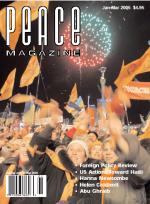
Peace Magazine Jan-Mar 2005, page 25. Some rights reserved.
Search for other articles by Polaris Institute here
George W Bush's state visit to Canada in November re-ignited unease about whether the government was being unduly pressured to sign on to ballistic missile defence (BMD). Here we present the Polaris Institute's ten frequently-asked-questions on the scheme.
The first phase, to be deemed operational by the end of 2004, calls for 10 ground-based missile interceptors placed in Alaska and California. Space sensors and ground radars would warn of a hostile missile attack, and the interceptors would be launched to collide with the enemy's incoming missile in outer space like "hitting a bullet with a bullet." Later phases include ship-based missile interceptors and a 747 jumbo jet mounted with a laser cannon. In the future interceptors and other weapons could be placed in orbit, introducing weapons into space for the first time.
The US is worried that "rogue nations" such as North Korea and Iran are developing missiles capable of striking North America (though they have none at present). The shield is also intended to handle an accidental missile launch by Russia or China of a small number of missiles, not an all-out attack.
Star Wars would have launched weapons into orbit that were capable of destroying many missiles as they travelled through space or as they launched. President George W. Bush's missile defence plan presently concentrates on sea- and ground-based interceptors. But President Bush has asked for millions of dollars for space weapons research and testing, which indicates that these systems will be added as technology permits. Even a report by the Canadian military pointed out that missile defence will likely result in weapons being put in space.
American and Canadian scientists argue that the technology is unproven and has a high probability of failing. Recent tests have resulted in failed intercepts, or did not replicate the unpredictability of a real attack. The military admits that it is deploying the system without operational testing, but argues that a rudimentary system is better than nothing.
Some analysts and the CIA suggest that a missile attack from a rogue nation is highly unlikely and that the major threat to the US is from terrorists who will use low-technology weapons or unorthodox methods to avoid defences. Others say missile defence is a distraction from other potential terrorist attacks and is draining funds for counter-terrorism intelligence capabilities.
Even more serious, missile defence will undermine efforts toward global nuclear disarmament that would remove the Russian and Chinese missile threats to North America.
Both. The shield is defensive if it protects the US against a surprise missile attack, but a missile shield is also offensive if it allows the US to attack a country first, shielding the US from retaliation.
The shield, if it works, would provide protection for Canadian cities. Most experts acknowledge that the US would be the main target of any attack, but Canada could be affected by the "downwind" effects of a nuclear or other form of attack near the Canada-US border. A successful attack on a US city would likewise affect Canada economically because of the highly integrated nature of the North American economy.
The Canadian government has suggested that Canada could participate at little or no cost since most of the work has already been paid for by the Americans. This is likely too good to be true. The US government will spend at least US$53 billion over the next five years for the system. Whether Canada will be asked to finance improvements to the system is not clear, but officials say that Canada's $300 million annual NORAD contribution and approximately $500 million already allotted for military satellites could be allocated to missile defence right away. Similarly, the first phase of the missile shield does not require Canadian territory. But former Defence Minister David Pratt refused to rule out future use of Canadian territory for radars or missile launchers, predictably on the East Coast. These would likely be at Canada's expense.
Missile defence supporters in the Canadian government argue that if Canada does not take part in the missile defence system, NORAD's importance will be jeopardized and Canada will have "no voice at the table." In August 2004, the Canadian government moved closer to full endorsement of missile defence by agreeing to allow data from NORAD to be shared with the US missile shield command, thereby answering any concerns over NORAD's future role in continental aerospace defence.
But American officials have reminded allies that they will have "no veto" over the system's future development, foreclosing any possibility of positive Canadian influence in preventing the deployment of space weapons.
Yes. The Chinese military has already said it will increase its armory of ballistic missiles. Tests of those missiles have already been conducted. The Russians claim to have tested a new manoeuvrable nuclear missile that renders the US missile shield useless against Russian technology, even before the shield is completed.

Peace Magazine Jan-Mar 2005, page 25. Some rights reserved.
Search for other articles by Polaris Institute here